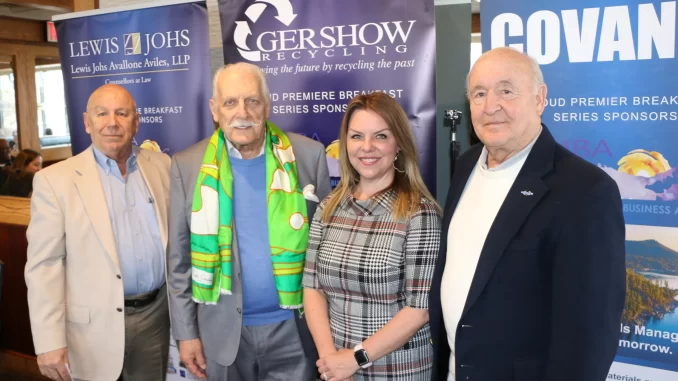
By Hank Russell
Kristen Reynolds, the president and CEO of Discover Long Island, spoke on the topic of commercial tourism on Long Island during the LIMBA (Long Island Metro Business Action) meeting at the Candlelight Diner in Commack on March 17. She shared with the audience how Long Island can bring more affluent business visitors to the region.
When Reynolds moved from Arizona seven years ago, she noticed that Long Island was lacking accommodations. “In Scottsdale, you can throw a rock and hit a Marriott, a Fairmont or an Omni,” she said. “You didn’t have that here [on Long Island] and it was so surprising to me.”
She also noticed that there wasn’t a convention center on Long Island. “I just couldn’t believe it because I had no idea, before I moved here, that we were the global headquarters of Estée Lauder, Canon and 1-800-FLOWERS,” she said.
As part of her position, she wants to disabuse people of the notion that Long Island has nothing to offer. “I look forward to continuing to show that’s not the case and Long Island is a very desirable place,” she said. “It is not just people leaving, it’s people coming.”
Tourism is a $6.3 million industry on Long Island, with visitors coming from around the world to “experience what we have here and are lucky to call home,” Reynolds said. She also noted that “we are very, very close” to securing initial funding of a convention center at Midway Crossings in Ronkonkoma. Once it is completed, “it will be a game changer.”
Reynolds said a convention center on Long Island is critical because it will draw in 3,000 to 5,000 business visitors a week, thanks to its proximity to the Long Island Rail Road and Islip MacArthur Airport. She also noted that it is equidistant from Manhattan and the Hamptons, making it ideal for “bleisure,” or business leisure, trips to either location. “It’s a great sales tactic.” Bleisure, according to Reynolds, is the second fastest-growing sector in the tourism industry since the pandemic lockdown ended.
Another advantage of having a convention center on Long Island is that business or nonprofit organizations can ask for a local thought leader, thereby saving money on having to fly out a guest speaker. Reynolds said this gives the speaker the opportunity to share with the audience what there is on Long Island that could be so attractive to the attendees.
“That raises the [region’s] intellectual capital and this is how businesses [say], ‘Wow, I didn’t know [Long Island] businesses had so much talent available there,” Reynolds said.
By bringing in tourists, Reynolds said, they provide additional tax revenue to the Island. “Every destination spot is fighting for these tourists because everyone knows that, when you come, you’re taxed on where you eat, sleep, shop, everything you do. … It’s just new money into the market.”
Plans for the convention center include the construction of an adjoining 300-room hotel and meeting place. “We want our adjoining hotels to get that overflow business… We want to build it in a way so that it’s immediately sold out all the time and then let the building happen naturally.” She also said the hotel will not be fully built out because there will be a part of land that will be reserved for the hotel’s future expansion, which is expected to happen in 10 years.
To attract visitors to Long Island, her organization put a lot of money into marketing, social media and search engine optimization so that they appear first on Google search. She also co-hosts Long Island Tea, a podcast in which she and Discover Long Island Chief Operating Officer Sharon Wyman discuss the Long Island tourism industry and living on Long Island in general. She started the podcast in 2020 during the pandemic; since then, it has garnered 20,000 downloads across 64 countries.
“We get to explore the hidden gems on Long Island as well as the iconic [sites] that we all appreciate,” she said.
LIMBA Chairman Ernie Fazio was impressed with the job she does to promote Long Island tourism. “I had no idea there were so many moving parts to what you do here,” he told her.
Another challenge Reynolds faced was educating people about Long Island. While many people heard the name “Long Island,” they did not know anything about the region, so she conducted a study of business executives to see if they had ever been to Long Island. Of that group, 42% came to Long Island. When asked if they were familiar with Suffolk or Nassau County, 12% of the visitors said they were familiar with Suffolk and only 9% knew about Nassau.
Reynolds said her organization collects and uses tracking data to follow visitors to determine if they are from Long Island or not, which tourist spots they visited, and where they spent their money; they then use the data they collected to “mimic like-minded consumer behavior and target those people across the country and across the globe.”
She is also attracting prospective high-net-worth visitors with its “Be-Long” campaign. “You can invite them and they will come. … We’re trying to attract the highest-yield customer, the one who spends the most money, target them and invite them to come when we want them to come,” Reynolds said.
Discover Long Island has teamed up with GetLocal to produce an app for visitors. “Wherever your phone is, that is what will come up near you [tourist sites],” she said. “This is going to be a game-changing, really great way to connect with visitors and bring them together.”
Reynolds said Long Island tourism is at “a pivotal time” with “so many transformational projects. There are a lot of great things that are strategically happening that would really allow us to lead on a local level.”

